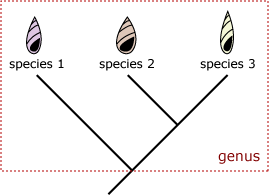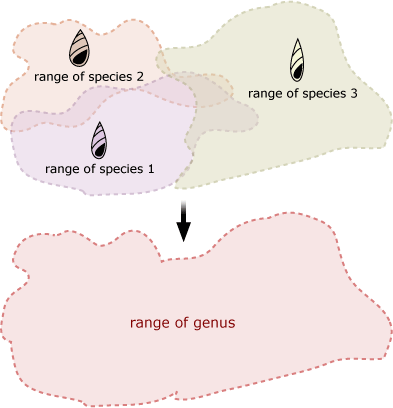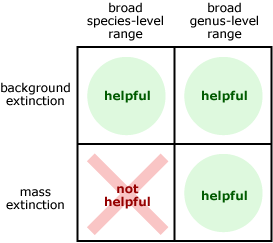Some of David Jablonski’s most intriguing results concern the impact of geographic range on a clade’s ability to resist extinction. However, these results are complex and vary depending on whether the clade being considered is a species (a narrowly-defined group of organisms that can all interbreed) or a genus (a clade of closely related species). Here’s a quick clarification:
- Species-level geographic range: This is the area over which an individual species lives. During times of normal background extinction, having a broad species-level geographic range is protective: genera composed of species with broad distributions are extinction resistant. However, during catastrophic mass extinctions, this trait is not particularly helpful. In that situation, having species with broad geographic ranges does not affect a genus’ risk of extinction.
- Genus-level geographic range: This is the total area over which a genus lives — the combined area that at least one of its species occupies. During times of normal background extinction, having a broad genus-level geographic range is protective: genera with broad distributions are extinction resistant. And, in contrast to species-level geographic range, for this trait, the same holds true during catastrophic mass extinctions: having a broad genus-level geographic range is always good for a clade’s extinction risk! Interestingly, it doesn’t matter how a genus achieves broad distribution: broadly distributed genera composed of many species with small ranges that form a large “patchwork” distribution are just as extinction resistant as broadly distributed genera composed of a few, more broadly distributed species.
The biggest surprise in these results is that broadly distributed genera are protected during mass extinctions (even if made up of species with small geographic ranges), but that genera with smaller geographic ranges (even if the species within them are relatively broadly distributed) are not protected. Why the difference? Why should range matter at the generic, but not the species, level? David hypothesizes that it has to do with the scale of ecosystem collapse during a mass extinction and the distribution of safe havens during that event. Perhaps, mass extinctions entail such widespread disaster and safe havens are so few and far between that even broadly-distributed species are unlikely to encounter a safe zone. Perhaps, it takes the even broader distribution of a genus before the clade stands a reasonable chance of having any one of its members wind up in a refuge.



